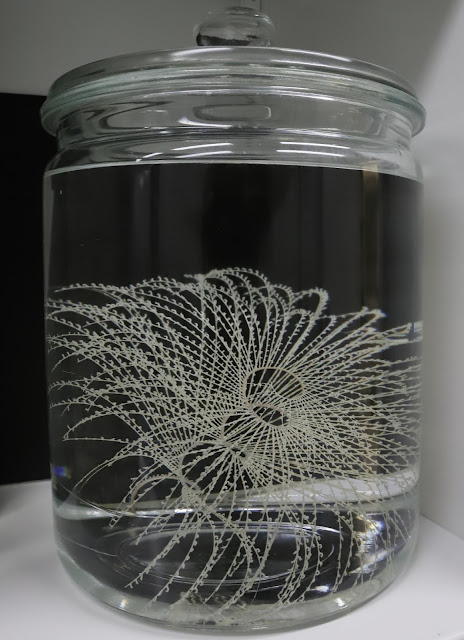YPM 38584: Iridogorgia fontinalis
IZ.038584 Iridogorgia fontinalis. Watling: HOLOTYPE. Atlantic Ocean. North America. Corner Rise Seamounts. ROV Hercules. Depth: 1325-1325 m. R/V Ronald Brown Cruise RB05-08, Deep Atlantic Stepping Stones. Coll: Watling, L. 17 Aug 2005. LatLon: 34.813, -50.504.
TAXONOMY
Animalia (Kingdom)
Cnidaria (Phylum) — contains cnidocytes (specialized cells for prey capture & predator defense)
Anthozoa (Class) — sea anemones & corals
Octocorallia (Subclass) — corals with 8-pinnate tentacles
Alcyonacea (Order) — incl. soft corals (do not produce calcium carbonate skeletons)
Chrysogorgiidae (Family)
Iridogorgia (Genus)
FORM
The species name alone describes the distinct shape of this coral. "fontinalis" refers to the fountain-like shape of the coral’s ‘upwardly-directed branches which evoke the shape of the water spray from a circular fountain’. As an octocoral, it features 8-fold symmetry. Louis Agassiz—Harvard invertebrate zoologist—described it as ‘forming a broad spiral like the skeleton of a spiral staircase’. The spiral nature of its growth may be analogous to other examples of "the golden spiral" in nature, otherwise known as the golden ratio. It's anchored to the bottom of the sea floor by a long calcareous stem. Polyps lining the branches aid in catching food particles from surrounding ocean currents (deep-sea corals don't rely on sunlight or photosynthetic algae to obtain energy and nutrients).
 |
| Photo by Eric Lazo-Wasem (2016) |
 |
| Photo by Eric Lazo-Wasem (2016) |
I. fontinalis lives in deep waters of the Atlantic, typically in cold temperatures of 4°C. Their habitat is in some of the most inaccessible areas of the ocean to humans—seamounts (submarine mountains), island ridges, rocky continental slopes—that require modern submersibles and remotely operated vehicles (ROVs) for collecting. This particular specimen was collected on an expedition in 2005 by Les Watling of University of Hawaiʻi at Mānoa .
 |
| Coordinates where I. fontinalis was collected (34.813N, -50.504W) |
 |
| Hercules ROV (Image courtesy of Ocean Exploration Trust/Nautilus Live) |
HISTORY
As difficult as deep sea specimens are to collect, even using modern technology, it isn’t the first Iridogorgia specimen in the Peabody’s collections. Yale’s first zoologist Addison Verrill was the first to describe the genus Iridigorgia with the species, Iridogorgia pourtalesii, in 1883. I. pourtalesii is typically found in higher waters, with temperatures more like 8°C, but certainly waters that qualify as deep-sea.
 |
| Original Verrill manuscript section on Iridigorgia |
 |
| Type plate illustrations by Verrill from Blake Expedition (highlighted figure #s for I. pourtalesii) |
 |
| Figures 7 & 7a: I. pourtalesii calicle illustrations by Verrill |
 |
| Left: I. pourtalesii holotype (70% alc), note: "on loan" to Les Watling Right: I. pourtalesii syntype (dry) Both specimens collected by Verrill |
Verrill identified the Iridogorgia specimen from a survey by the U.S. Fish Commission. The Fish Commission was interested in gathering comprehensive information on the distribution of animal life of the northern Atlantic coast and offshore into the Gulf Stream to relate nature—especially the supply of food of fish—to the distribution and abundance of fish themselves. Verrill was appointed as a marine investigator to make observations and collect specimens. Deep-sea exploration technology developed to make obtaining samples and specimens easier. The Steamer Blake—which I. pourtalesii was collected on—was the first vessel to be outfitted with wire rope for deep-sea dredging.
 |
| Coast and Geodetic Survey Steamer Blake, 1874-1905 (Image courtesy of NOAA Photo Library) |
 |
| Steamer Blake's ship steel-wire cable for deep-sea dredging (Image courtesy of NOAA Photo Library) |
TODAY
Perhaps what's so mesmerizing about I. fontinalis is the elegant, yet resilient aspects of its form that have adapted to the furthest depths of the ocean. Darkness and frigid waters seem like harsh conditions, but the habitat can also be described as tranquil (pacific even, if you want to project the meaning of another ocean's name): free from most natural disturbances like hurricanes and falling sediment, relatively stable salinity levels, and constant temperature. More recently though, the serene is not so guaranteed. The same technology that's enabled deep-sea exploration have advanced other areas outside of marine research. Energy interests in deep-sea mining for mineral deposits—manganese, copper, zinc, nickel, aluminum, lithium, cobalt—have increased drilling activity and pollution in large areas of habitat. Above-ground, the technological advances that contribute to emissions into the atmosphere cascade into effects of ocean acidification. Even salinity levels are shifting from rising sea levels. I. fontinalis remains a rare and exquisite species of the seamounts. They live for hundreds of years in the ocean's inky black depths, if the waters around them can remain calm.



Comments
Post a Comment